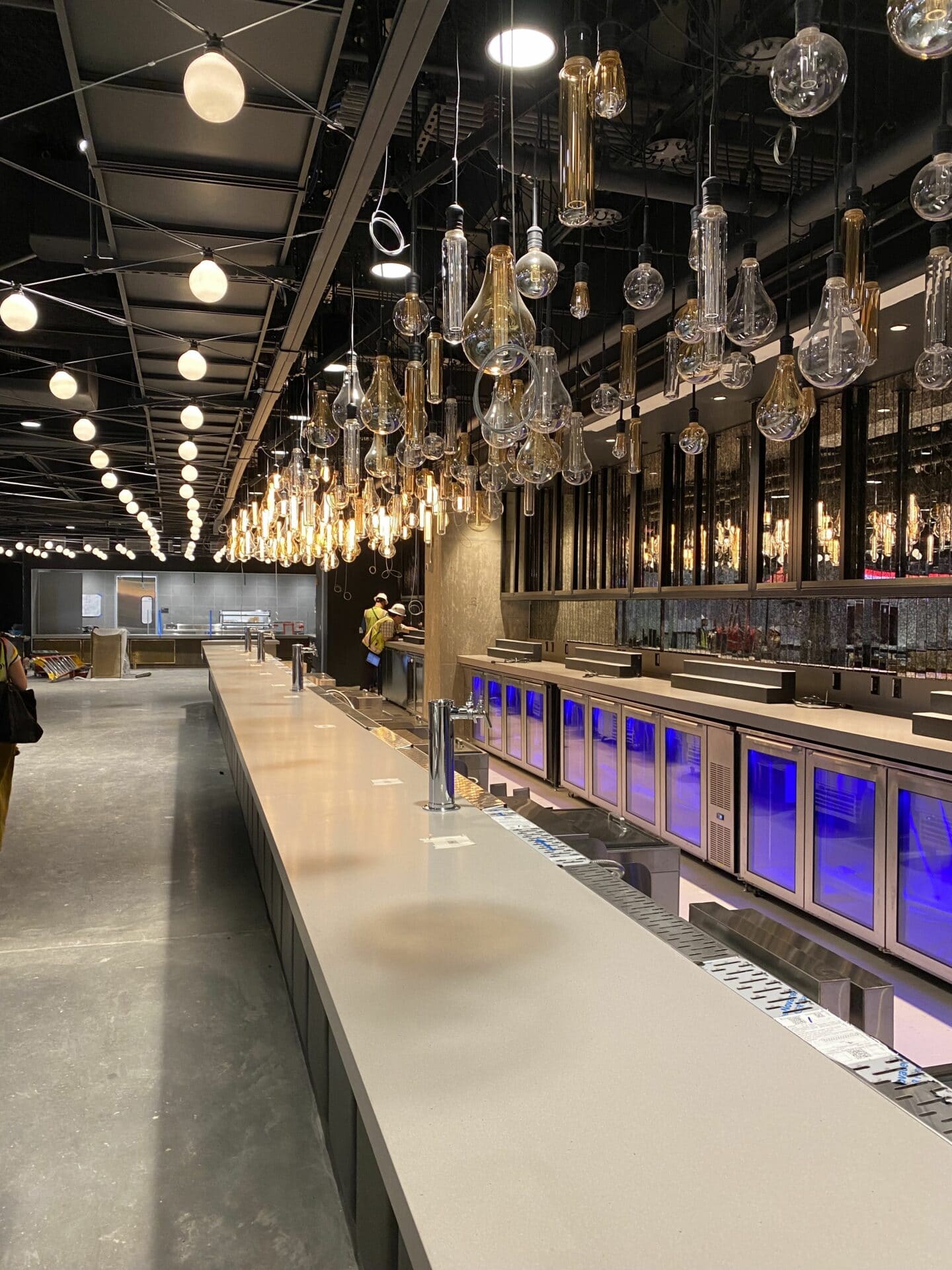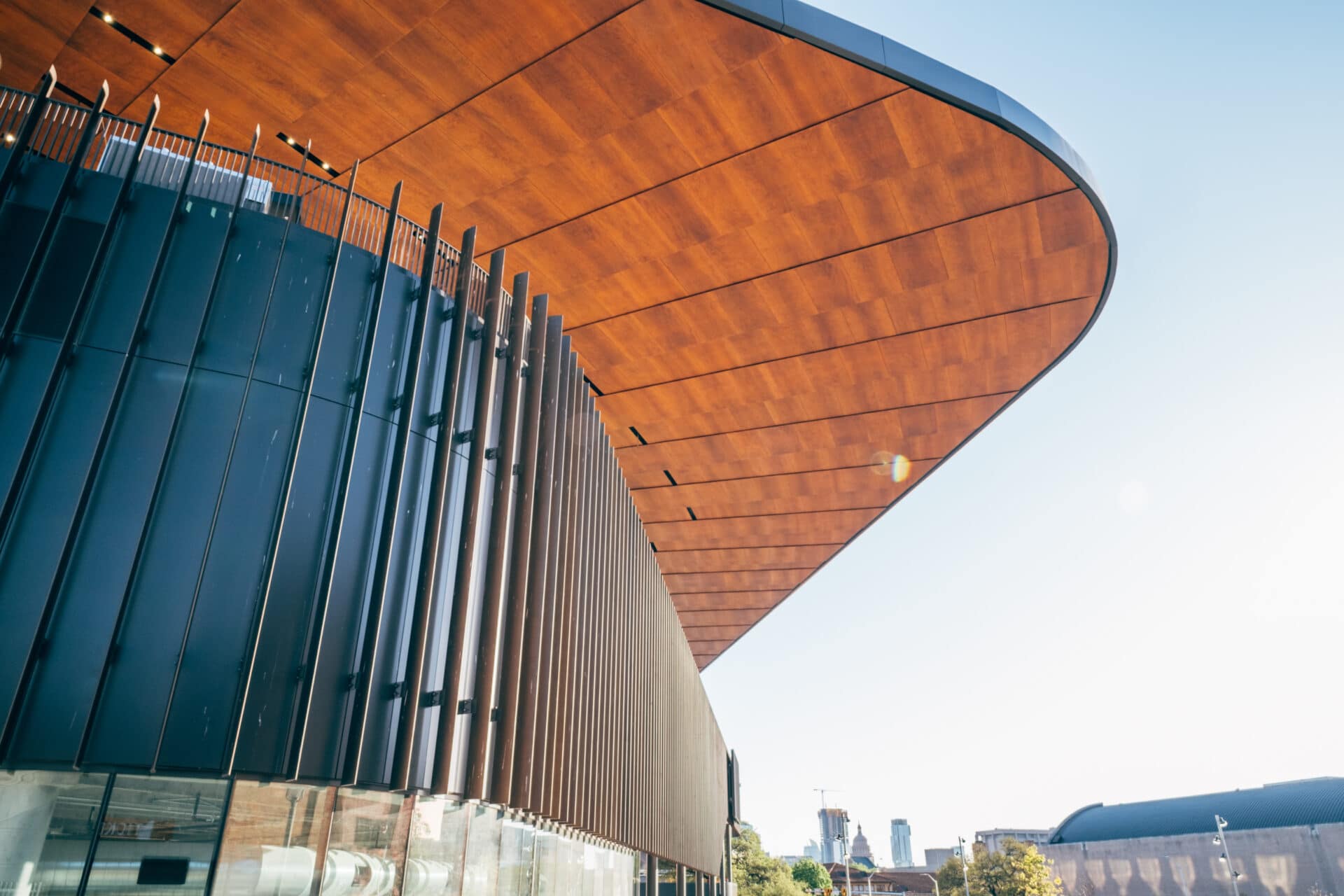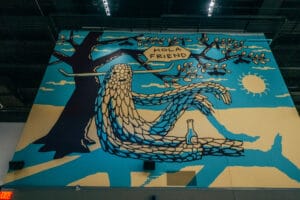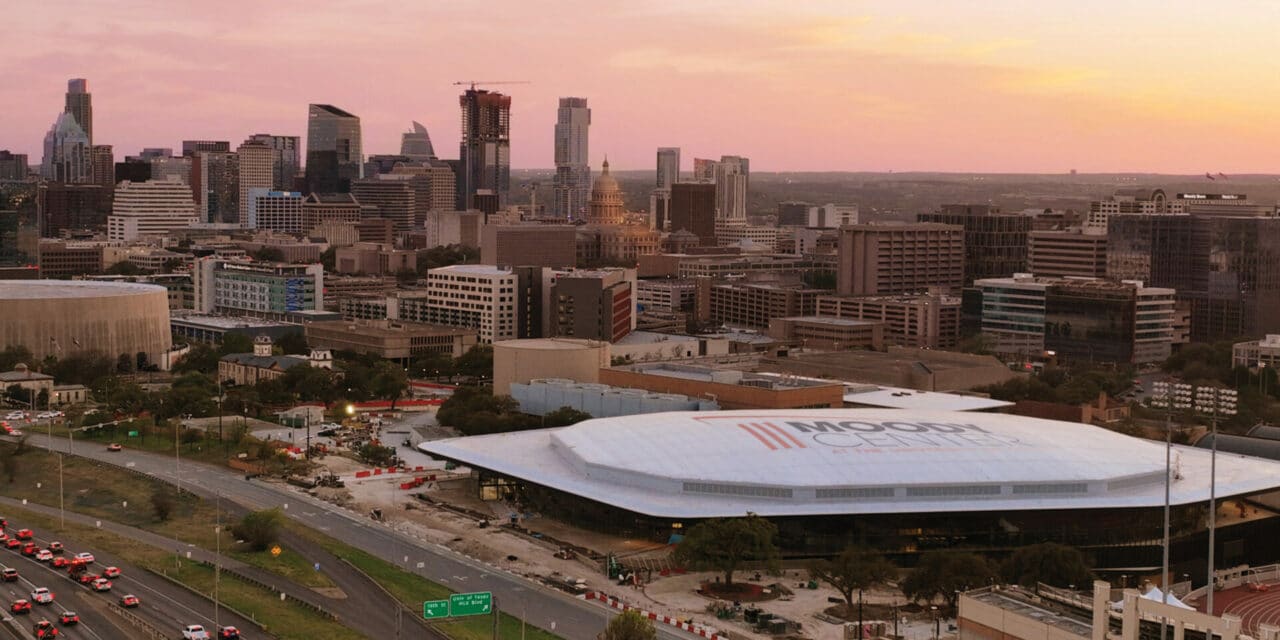FROM THE TOP: With Interstate 35 on one side of Moody Center and the rest of The University of Texas campus on the other, the venue has outdoor spaces offering stunning views of the campus and city.
MOODY CENTER TAKES THE LIVE MUSIC CAPITAL TO ANOTHER LEVEL
The juxtaposition of new and old tells a story in Austin, Texas. Gleaming glass-faced skyscrapers like the Indeed and Frost Bank towers soar above low-slung 19th century brick structures, many featuring historical markers, others bearing some of the city’s numerous colorful murals.
Embracing the new while preserving its past has been a hallmark of Austin’s emergence as one of America’s fastest-growing cities and the new Moody Center arena on the sprawling, oak-lined University of Texas campus aims to strike a similar balance.
The new home of UT men’s and women’s NCAA Division I basketball, the 15,000-capacity-plus Moody Center will replace 45-year-old Frank C. Erwin Jr. Events Center, the facility known affectionately as The Drum for its cylindrical, windowless exterior design.
The Drum is slated to host this year’s UT commencement ceremonies, but it is tentatively set to be torn down to make way for the expansion of the campus’ Dell Medical Center.
With its sleek glass-and-wood exterior, contoured roof, and state-of-the-art sound, lighting, staging, seating and luxury amenities for guests and artists, Moody Center represents a major upgrade.
See Also:
AECOM HUNT’S SID PERKINS KEPT MOODY CENTERED
MOODY CENTER BRINGS FRESH DESIGN TO UT CAMPUS
BOK TOGETHER: NICKLER & SPARKS LEAD THE WAY FOR MOODY CENTER

YES INDEED: Decorative lighting makes for a compelling touch in the Indeed Club, named for the job search platform. (James Zoltak/Staff)
“The (Erwin Center) was fantastic for many years. We had wonderful concerts coming in and out of there, but Austin touted itself as the live music capital of the world, and we weren’t. We were still a B market for many years. Now we’re an A market,” said Charles Attal, co-founder of Austin-based C3 Presents.
The music promoter’s majority owner is Live Nation, an equal partner with VenuesNow parent company Oak View Group in the arena. OVG privately financed Moody Center and will operate it.
“That’s one of the key components that they had in mind. From the design, the architecture of the building, all the way through construction, is how do we make the road life a little bit easier on these tours? The Frank Erwin Center here, I think only had one loading dock. We have five underground spaces for the trucks to back in and unload. It’s a short push to the stage,” said Michael Owens, Moody Center’s vice president of programming.
“When they come into the building and they get off their smelly bus they’ve been on for six months, they don’t want to come into a hockey locker room with pipe and drape,” he continued. “They want hospitality and we’re going to deliver that with our world-class artist dressing rooms and catering and production offices. They’re going to get a warm welcome and an unforgettable, unbeatable experience at Moody Center.”
“No band is going to skip our market anymore,” Attal said. “The ability to get in and out and just the amenities alone in the building will sell tickets.”
NEW BEGINNING
Gensler designed the $375 million Moody Center (see page 22), AECOM Hunt built it and Walter P Moore was the structural engineer. CAA Icon served as owner’s representative.
“Our first interest (in Austin) was in 2017,” said Francesca Bodie, OVG’s president of business development. “We made a trip down here and after seeing what Charles had created with Charlie Walker at Austin City Limits, we said, ‘If you ever figure it out, this would be great. This vibrancy in Austin is not new. They’ve been building it for decades. The University of Texas issued a request for information and we pulled our team together. We had a great relationship with (former UT President) Greg Fenves (now Emory University President) and OVG already had a relationship with Live Nation.”
Bodie said she hadn’t met Attal at that point, but she reached out to his office and said, “Hey, we’re a new company and this is what we want to do.”
“He immediately got it,” Bodie said. “I don’t think we would have submitted the bid and the vision for what this could be without C3 and specifically Charles telling us and sitting in on every design meeting. He and Matthew (McConaughey, actor and UT’s Minister of Culture) sat in on each and every one of them.”
Bodie’s father, OVG Chairman and Co-Founder Tim Leiweke, and McConaughey had known each other since a subsidiary of AEG, where Leiweke was president and CEO, produced the film “Sahara,” starring McConaughey.
“We know we’re not from Austin and we definitely needed to have authentic Austinites in our mix telling us how to do this the right way and at the time the partners were like, ‘let’s go and do something great,” Bodie said. “No one wanted to do something that wasn’t going to stand the test of time (and) be authentic to Austin.”
“When they called, I did jump at the chance,” Attal said. “We were desperately in need of a new arena. Our town was exploding before COVID. I grew up in the old building, knew every nook and cranny.”
Drew Martin, UT executive senior associate athletic director for external services, was deeply connected with the Moody Center project. Martin said the school could have built the arena on its own, funded in part by one of the richest alumni bases in the country, but in the end, UT preferred to go with a private developer and a top-flight operator to run it.
“We had probably taken (the Erwin Center) as far as we could with renovations and footprints and infrastructure,” Martin said. “It was time for a world-class university to have a world-class building.”
The school plans to use Moody Center 60 days a year, keeping revenue generated from games and events such as graduations, speaker series and other education-related programming, he said.
Martin said the level of cooperation between OVG and the university allows for collaboration should scheduling flexibility be needed.
Moody Center is part of UT’s overall program of upgrading its athletics facilities, Martin said.
“Since Chris Del Conte, our athletic director, came in 2017, we have embarked on roughly a billion dollars in capital improvements from football to swimming and diving to baseball to softball and the basketball arena,” he said. “It’s all within a plan to upgrade specifically the athletics complex.”
Campus construction mirrors what’s been going on throughout Austin. “Our official bird of the city of Austin is the crane, I believe, because there are cranes all over the skyline and certainly on campus as well,” Martin joked.
ADVANTAGE: LONGHORNS
Attal’s contributions went beyond music as he and UT alum McConaughey share a passion for Longhorns athletics. The two pushed to ensure that Moody Center provides a true home court advantage when UT takes the court.
“If you’re a UT basketball player and you walk into this building, it’s going to be like playing in an NBA arena,” Bodie said.
“We know the storied programs put the students on one side of the building on the floor with the best seats in the house,” Attal said. “We didn’t have that. Students were scattered around, they were behind the goals, but in the new arena, the students will be down on the floor and they’ll have the donors on the other side.”

LET THE LIGHT IN: Moody Center, pictured during the late stages of construction, offers views of its surroundings that were not available to those inside the Erwin Center, aka ‘The Drum,’ the windowless arena it’s replacing. (Courtesy Ryan Vestil)
A mechanical partitioning system that lowers from the ceiling to seal off the upper bowl will help create an intimidating setting.
“It comes down out of the ceiling and it truly closes off the balcony to where it doesn’t feel like a curtain system,” Attal said. “It’s going to be a true vibe for basketball, what we desperately needed in the marketplace for UT to keep us competitive. Moving to the SEC from the Big 12, you need every little inch of competitiveness you can get.”
With Interstate 35 on one side and the rest of the campus on the other, Moody Center has outdoor spaces offering views into the Mike A. Myers Track and Soccer Stadium and the outside of Darrell K. Royal-Texas Memorial Stadium, not to mention iconic views of the campus and city.
“I think it’s going to be one the hottest buildings in the country for years to come,” said Attal, a driving force behind Austin City Limits Music Festival, as well as Lollapalooza’s expansion into a multi-continent festival juggernaut. “The outdoor deck on the mezzanine is going to be a great hang. You go to a lot of arenas, you’re kind of stuck; you get in, you’ve got nowhere to go. Get to your seat, and you’ve got to get out. Here, you can go to the clubs and out to our balcony where you can see the state capitol, Texas Tower, all in one shot. That upper level bowl is going to be a party.”
The arena’s 44 suites are sold out, as are the 2,000 concert memberships that get first dibs on ticket purchases before the general public.
AUTHENTIC ATX
Remaining authentic amid explosive growth has been a hallmark of Austin’s emergence as a sought-after locale and that philosophy of embracing the new while respecting the city’s rich, historical past is evident at Moody Center.
“Every single level of the building has unique aesthetics and design features specific to Austin,” Bodie said.

KEEPING AUSTIN WEIRD: Oak View Group commissioned six murals from local artists that will grace Moody Center’s interior. (Courtesy Ryan Vestil)
Attal and McConaughey held brainstorming sessions with the architects and some informal ones as well, where the idea of ‘Porch Suites’ was born.
“Charles and I were leaning against the rail at his boat house overlooking Lake Austin a few years ago and it hit me that we were on a quintessentially ‘Austin’ front porch, having a particularly ‘Austin’ experience — the informality, the relaxation, the transparency — it makes your Tuesday feel more like a Saturday, puts you in a good mood,” McConaughey said.
“Additionally, I thought it was important to place the bar in each porch suite on the court side of the suite rather than in the back where most suite bars are,” he continued. “Why? Because what happens when you get up to get a drink in traditional ‘bar in the back’ suites? You turn your back to the action, retreat to the bar, order a drink, wait, start a conversation, and all the while you’re missing the action on the floor that you came to see. Plus, my favorite place to watch a game or a live event is standing at a bar.”
As a live music mecca, Austin has venues to serve every phase of a band’s development, from clubs and theaters on up to Moody Center and sheds like Germania Insurance Amphitheater at Circuit of the Americas and Moody Amphitheater at Waterloo Park.
“The crazy thing is that Red River (Street) has everything from a 200-capacity club to the Mohawk to Stubb’s to the Moody Amphitheater to Moody Center,” Attal said. “They’re all on one street, which is unheard of.”
The city needs the top tier bands to make Austin a must stop on their tour routes, he said.
“The ticket buyer is there,” Attal said. “Everything we have on sale now is just off the charts, so we’re really happy. We’re going to have 50 to 60 touring shows come through instead of 20. It’s a big lift and it’s also a big economic impact for the city.”
PRODUCTION CAPABILITIES
Moody Center’s back-of-house production for touring shows is top shelf. Artists can get off their bus and go directly to their dressing rooms.
“You’ve got to make the facility a great experience for the fans, but you also do it for the bands because you want them to come back,” Attal said. “If they have a bad day, you’re going to get the call. They may skip the market next time. You’ve got to have the back of the house be just as good as the front. We have both.”
Some arenas see reduced business in the summer months, when sheds and festivals take center stage, but central Texas summers get pretty toasty and Moody Center will offer a cool setting in more ways than one.
“In July and August people are going to want to play indoors too,” Attal said. “I don’t think there’s a slow season in Austin anymore and we’re going to be building half houses. That (partition) system — you’re not going to feel like you’re playing in a giant room. “You’ll see a lot of 5,000-to-7,000-seat shows and that will help fill up the calendar.”
“This building is the best example of a great design, a great construction team and a great market coming together,” Bodie said. “People don’t even know what they are about to get in this city. I think the wow factor is going to ripple through the community.”
Moody Center could become part of annual Austin festivals and events such as South by Southwest and Austin City Limits. Attal said it’s possible for a band to play ACL and Moody Center during a single tour stop.
“We’ve talked about it,” he said. “Whether we do an after show in the building or we do some pre-shows around ACL.”
MODEL FOR THE FUTURE?
Asked if OVG’s vision is to take the financial formula applied at UT to develop venues at other major schools, Bodie said replicating the Austin blueprint would be difficult.
“I would love to, but I don’t know if it’s possible,” she said. “There are so many things that happened to make this project become a reality, whether it was the timing — we brought this out before COVID — we’re in a right to work state, we had a local design and architecture team.
“Our partners were here. So many pieces don’t exist in some of our projects, like Baltimore (where OVG is renovating Baltimore Arena), where there’s a significant difference in pricing than a few years ago.”
That said, Bodie believes Moody Center will change the way college sports venues are developed and operated, with music and other live entertainment figuring prominently in the revenue generation picture.
“We value music,” she said. “We value live entertainment and there’s a way to build these buildings better.
“Austin is a special place that has a tremendous amount of momentum and this building is going to reflect a moment in time for this city. I don’t know if we’ll ever recreate it. We love the partnership with UT and with Live Nation. If we could figure out a way to replicate it with other schools we would be open to it.”







